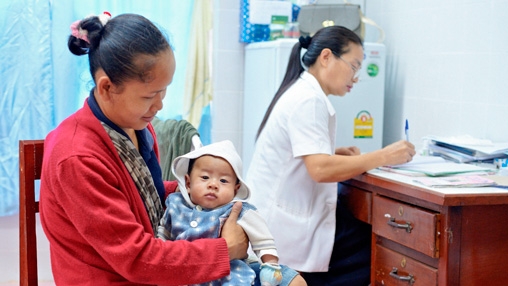VIENTIANE, August 29, 2011 — 20-year-old Nang Buey is being rushed to the nearest hospital. Pale and profusely bleeding, she endures the 180-kilometer journey on the rough road between her Tapangthong District home to Savannakhet Provincial Hospital. Intense stomach pains, followed by contractions, had woken her in the morning. Following traditional beliefs, her husband and father-in-law performed prayers and rituals to ease her suffering. They would later hire a truck from neighbors to take her to hospital. She was immediately rushed to the operating room for emergency surgery and a blood transfusion. The diagnosis was an ‘ectopic pregnancy’ or a life-threatening but treatable condition where a fetus develops outside the womb.
Regular prenatal check-ups or an emergency treatment like Nang Buey’s comes with a price tag that goes beyond the means of most rural families in Lao PDR, where 75% of people live on less than US$2 a day. Fortunately, in Savannakhet, maternal health services and deliveries are free in government health facilities.
Prioritizing Maternal Health
Inspired by the fifth millennium development goal—to reduce maternal deaths—the Lao PDR government is piloting free facility-based maternal deliveries in Nong and Thapanthong districts as part of the Health Service Improvement Project (HSIP), for which the World Bank supported through an initial US$15 million grant. The Bank provided the project with an additional US$12.4 million in May 2011. Other development partners, such as the World Health Organization and the United Nations Development and Population Fund, are implementing similar projects in other parts of the country.
The Lao PDR government aims to reduce maternal, newborn and child mortality as part of the Global Strategy for Women's and Children's Health. It commits to provide free deliveries in order to ensure access to the most vulnerable; produce 1,500 new midwives by 2015 by upgrading existing staff and training and recruiting new staff; and increasing of births attended by a skilled attendant.
Emphasizing Safe Childbirth at Health Facilities
Dr Phetdara Chanthala, a World Bank health specialist and former surgeon, says: “Although the number of Lao mothers who die from childbirth and related complications has decreased, the number is still strikingly high compared to other countries in the region,”
“This is due to several factors: the high rate of home deliveries without medical assistance in rural areas, bad transport and communication during the rainy season, and lack of health information,”
The economic burden is not the only factor keeping women from safe deliveries. Traditions and beliefs also constitute an obstacle in ensuring that women get the right treatment. Certain communities believe that a woman must give birth in the forest by herself.
Aside from free deliveries, the program tries to address these factors through the training of health workers and midwives, holding of health committee meetings, and community-based health education.
The impact of the pilot is currently being studied but preliminary results suggest a significant increase in childbirths in health facilities since services being provided are for free. As such, the mothers who delivered at health facilities were at much lower risk of fatal complications. Thanks to the timely access to a safe health facility, women like Nang Buey are alive today.


